University Nursing Report: Approaches for Leaders to Handle Bullying
VerifiedAdded on 2022/08/16
|11
|2216
|142
Report
AI Summary
This report delves into the critical issue of workplace bullying within the nursing profession, examining its detrimental effects on nursing outcomes and patient care. It emphasizes the pivotal role of nursing leaders in mitigating bullying through the implementation of various strategies and approaches. The report highlights the importance of professional standards, such as zero-tolerance policies and the D.E.S.C. strategy, in preventing bullying behaviors. It also explores the significance of leadership styles, including embodied and diplomatic approaches, in fostering a respectful and supportive work environment. Furthermore, the report underscores the value of technology and information management in enhancing communication and coordination within healthcare settings. By providing a comprehensive overview of these key elements, the report aims to equip nursing leaders with the knowledge and tools necessary to effectively address and eradicate workplace bullying, ultimately improving the well-being of nurses and the quality of patient care.
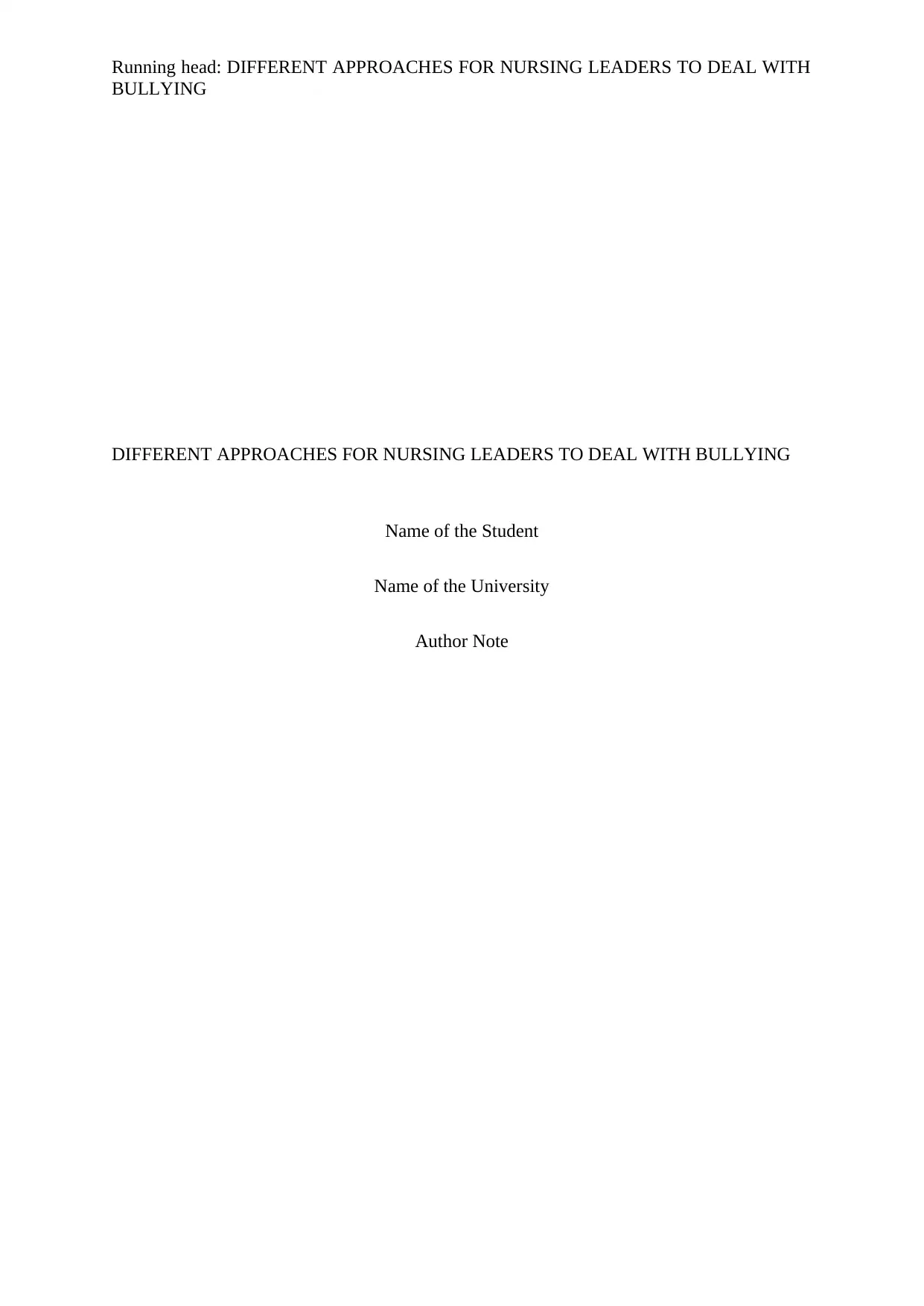
Running head: DIFFERENT APPROACHES FOR NURSING LEADERS TO DEAL WITH
BULLYING
DIFFERENT APPROACHES FOR NURSING LEADERS TO DEAL WITH BULLYING
Name of the Student
Name of the University
Author Note
BULLYING
DIFFERENT APPROACHES FOR NURSING LEADERS TO DEAL WITH BULLYING
Name of the Student
Name of the University
Author Note
Paraphrase This Document
Need a fresh take? Get an instant paraphrase of this document with our AI Paraphraser
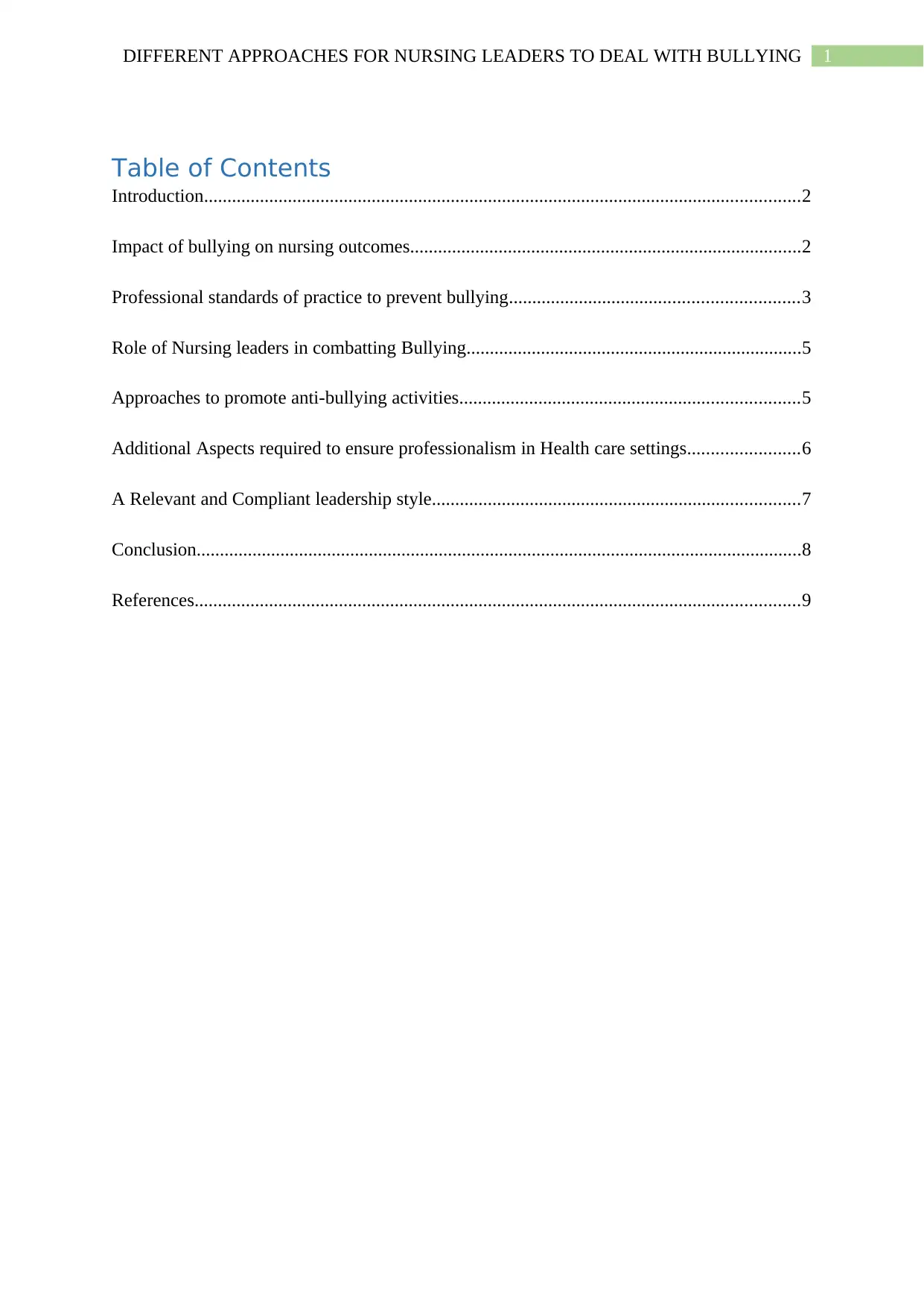
1DIFFERENT APPROACHES FOR NURSING LEADERS TO DEAL WITH BULLYING
Table of Contents
Introduction................................................................................................................................2
Impact of bullying on nursing outcomes....................................................................................2
Professional standards of practice to prevent bullying..............................................................3
Role of Nursing leaders in combatting Bullying........................................................................5
Approaches to promote anti-bullying activities.........................................................................5
Additional Aspects required to ensure professionalism in Health care settings........................6
A Relevant and Compliant leadership style...............................................................................7
Conclusion..................................................................................................................................8
References..................................................................................................................................9
Table of Contents
Introduction................................................................................................................................2
Impact of bullying on nursing outcomes....................................................................................2
Professional standards of practice to prevent bullying..............................................................3
Role of Nursing leaders in combatting Bullying........................................................................5
Approaches to promote anti-bullying activities.........................................................................5
Additional Aspects required to ensure professionalism in Health care settings........................6
A Relevant and Compliant leadership style...............................................................................7
Conclusion..................................................................................................................................8
References..................................................................................................................................9
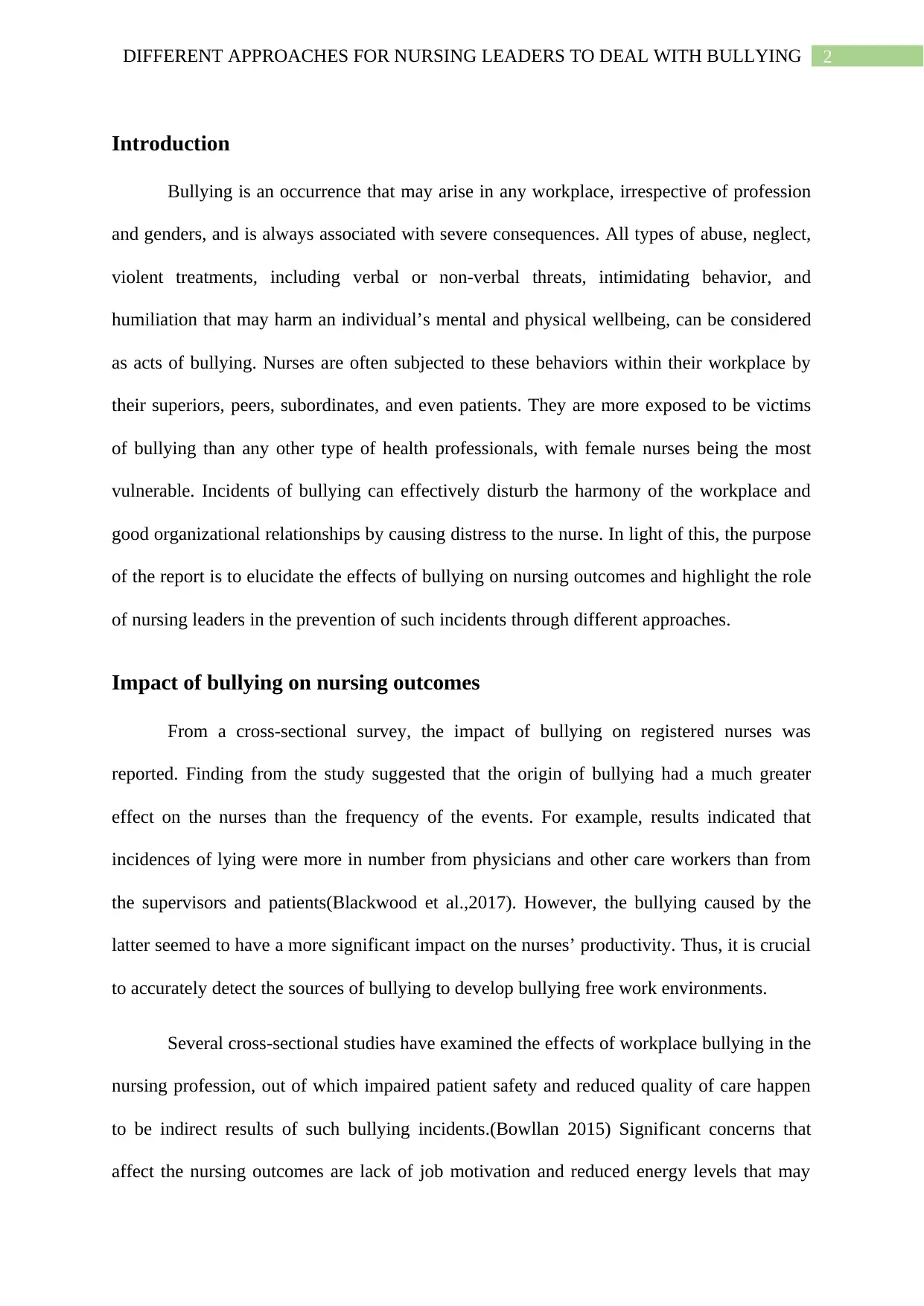
2DIFFERENT APPROACHES FOR NURSING LEADERS TO DEAL WITH BULLYING
Introduction
Bullying is an occurrence that may arise in any workplace, irrespective of profession
and genders, and is always associated with severe consequences. All types of abuse, neglect,
violent treatments, including verbal or non-verbal threats, intimidating behavior, and
humiliation that may harm an individual’s mental and physical wellbeing, can be considered
as acts of bullying. Nurses are often subjected to these behaviors within their workplace by
their superiors, peers, subordinates, and even patients. They are more exposed to be victims
of bullying than any other type of health professionals, with female nurses being the most
vulnerable. Incidents of bullying can effectively disturb the harmony of the workplace and
good organizational relationships by causing distress to the nurse. In light of this, the purpose
of the report is to elucidate the effects of bullying on nursing outcomes and highlight the role
of nursing leaders in the prevention of such incidents through different approaches.
Impact of bullying on nursing outcomes
From a cross-sectional survey, the impact of bullying on registered nurses was
reported. Finding from the study suggested that the origin of bullying had a much greater
effect on the nurses than the frequency of the events. For example, results indicated that
incidences of lying were more in number from physicians and other care workers than from
the supervisors and patients(Blackwood et al.,2017). However, the bullying caused by the
latter seemed to have a more significant impact on the nurses’ productivity. Thus, it is crucial
to accurately detect the sources of bullying to develop bullying free work environments.
Several cross-sectional studies have examined the effects of workplace bullying in the
nursing profession, out of which impaired patient safety and reduced quality of care happen
to be indirect results of such bullying incidents.(Bowllan 2015) Significant concerns that
affect the nursing outcomes are lack of job motivation and reduced energy levels that may
Introduction
Bullying is an occurrence that may arise in any workplace, irrespective of profession
and genders, and is always associated with severe consequences. All types of abuse, neglect,
violent treatments, including verbal or non-verbal threats, intimidating behavior, and
humiliation that may harm an individual’s mental and physical wellbeing, can be considered
as acts of bullying. Nurses are often subjected to these behaviors within their workplace by
their superiors, peers, subordinates, and even patients. They are more exposed to be victims
of bullying than any other type of health professionals, with female nurses being the most
vulnerable. Incidents of bullying can effectively disturb the harmony of the workplace and
good organizational relationships by causing distress to the nurse. In light of this, the purpose
of the report is to elucidate the effects of bullying on nursing outcomes and highlight the role
of nursing leaders in the prevention of such incidents through different approaches.
Impact of bullying on nursing outcomes
From a cross-sectional survey, the impact of bullying on registered nurses was
reported. Finding from the study suggested that the origin of bullying had a much greater
effect on the nurses than the frequency of the events. For example, results indicated that
incidences of lying were more in number from physicians and other care workers than from
the supervisors and patients(Blackwood et al.,2017). However, the bullying caused by the
latter seemed to have a more significant impact on the nurses’ productivity. Thus, it is crucial
to accurately detect the sources of bullying to develop bullying free work environments.
Several cross-sectional studies have examined the effects of workplace bullying in the
nursing profession, out of which impaired patient safety and reduced quality of care happen
to be indirect results of such bullying incidents.(Bowllan 2015) Significant concerns that
affect the nursing outcomes are lack of job motivation and reduced energy levels that may
⊘ This is a preview!⊘
Do you want full access?
Subscribe today to unlock all pages.

Trusted by 1+ million students worldwide
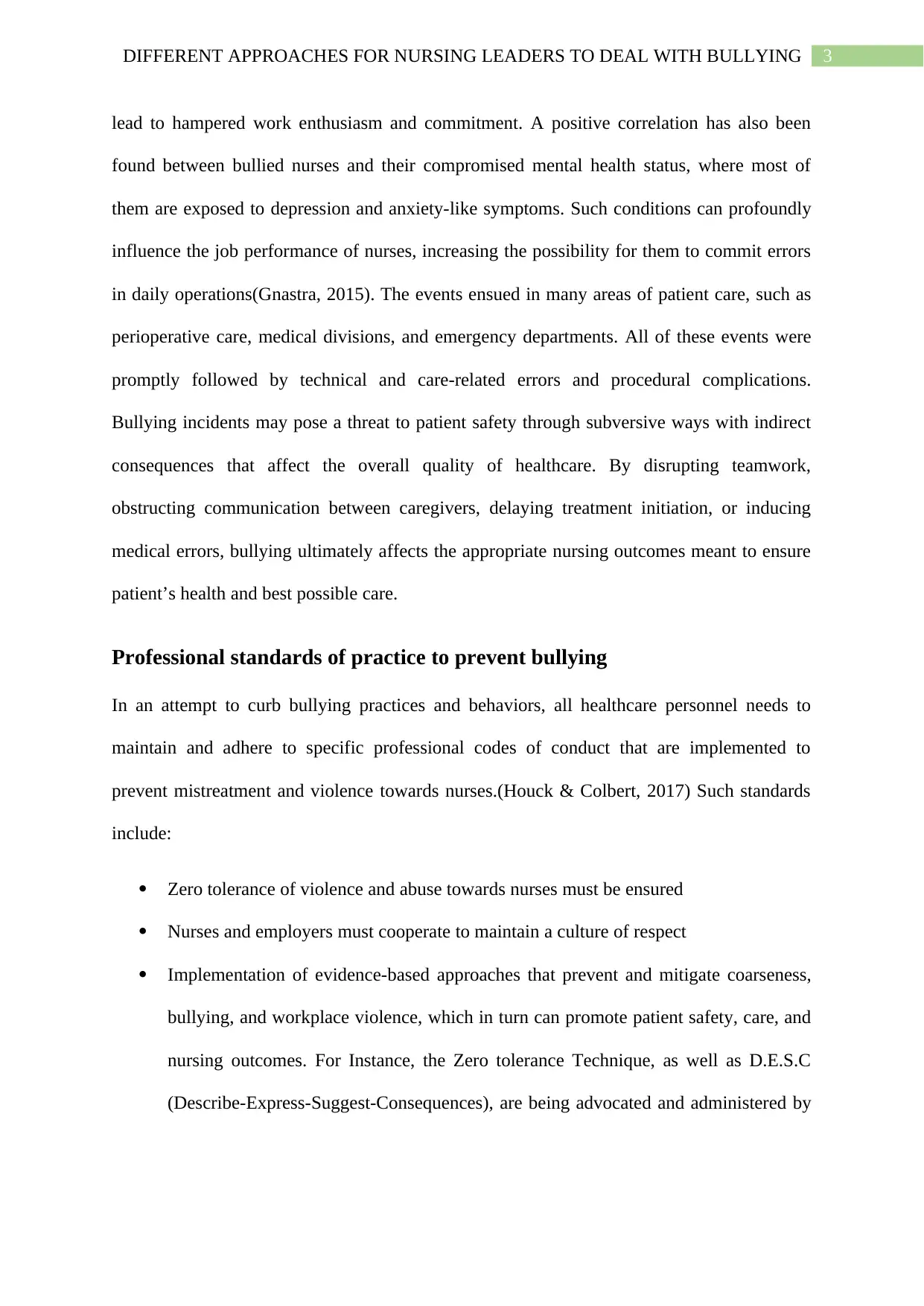
3DIFFERENT APPROACHES FOR NURSING LEADERS TO DEAL WITH BULLYING
lead to hampered work enthusiasm and commitment. A positive correlation has also been
found between bullied nurses and their compromised mental health status, where most of
them are exposed to depression and anxiety-like symptoms. Such conditions can profoundly
influence the job performance of nurses, increasing the possibility for them to commit errors
in daily operations(Gnastra, 2015). The events ensued in many areas of patient care, such as
perioperative care, medical divisions, and emergency departments. All of these events were
promptly followed by technical and care-related errors and procedural complications.
Bullying incidents may pose a threat to patient safety through subversive ways with indirect
consequences that affect the overall quality of healthcare. By disrupting teamwork,
obstructing communication between caregivers, delaying treatment initiation, or inducing
medical errors, bullying ultimately affects the appropriate nursing outcomes meant to ensure
patient’s health and best possible care.
Professional standards of practice to prevent bullying
In an attempt to curb bullying practices and behaviors, all healthcare personnel needs to
maintain and adhere to specific professional codes of conduct that are implemented to
prevent mistreatment and violence towards nurses.(Houck & Colbert, 2017) Such standards
include:
Zero tolerance of violence and abuse towards nurses must be ensured
Nurses and employers must cooperate to maintain a culture of respect
Implementation of evidence-based approaches that prevent and mitigate coarseness,
bullying, and workplace violence, which in turn can promote patient safety, care, and
nursing outcomes. For Instance, the Zero tolerance Technique, as well as D.E.S.C
(Describe-Express-Suggest-Consequences), are being advocated and administered by
lead to hampered work enthusiasm and commitment. A positive correlation has also been
found between bullied nurses and their compromised mental health status, where most of
them are exposed to depression and anxiety-like symptoms. Such conditions can profoundly
influence the job performance of nurses, increasing the possibility for them to commit errors
in daily operations(Gnastra, 2015). The events ensued in many areas of patient care, such as
perioperative care, medical divisions, and emergency departments. All of these events were
promptly followed by technical and care-related errors and procedural complications.
Bullying incidents may pose a threat to patient safety through subversive ways with indirect
consequences that affect the overall quality of healthcare. By disrupting teamwork,
obstructing communication between caregivers, delaying treatment initiation, or inducing
medical errors, bullying ultimately affects the appropriate nursing outcomes meant to ensure
patient’s health and best possible care.
Professional standards of practice to prevent bullying
In an attempt to curb bullying practices and behaviors, all healthcare personnel needs to
maintain and adhere to specific professional codes of conduct that are implemented to
prevent mistreatment and violence towards nurses.(Houck & Colbert, 2017) Such standards
include:
Zero tolerance of violence and abuse towards nurses must be ensured
Nurses and employers must cooperate to maintain a culture of respect
Implementation of evidence-based approaches that prevent and mitigate coarseness,
bullying, and workplace violence, which in turn can promote patient safety, care, and
nursing outcomes. For Instance, the Zero tolerance Technique, as well as D.E.S.C
(Describe-Express-Suggest-Consequences), are being advocated and administered by
Paraphrase This Document
Need a fresh take? Get an instant paraphrase of this document with our AI Paraphraser
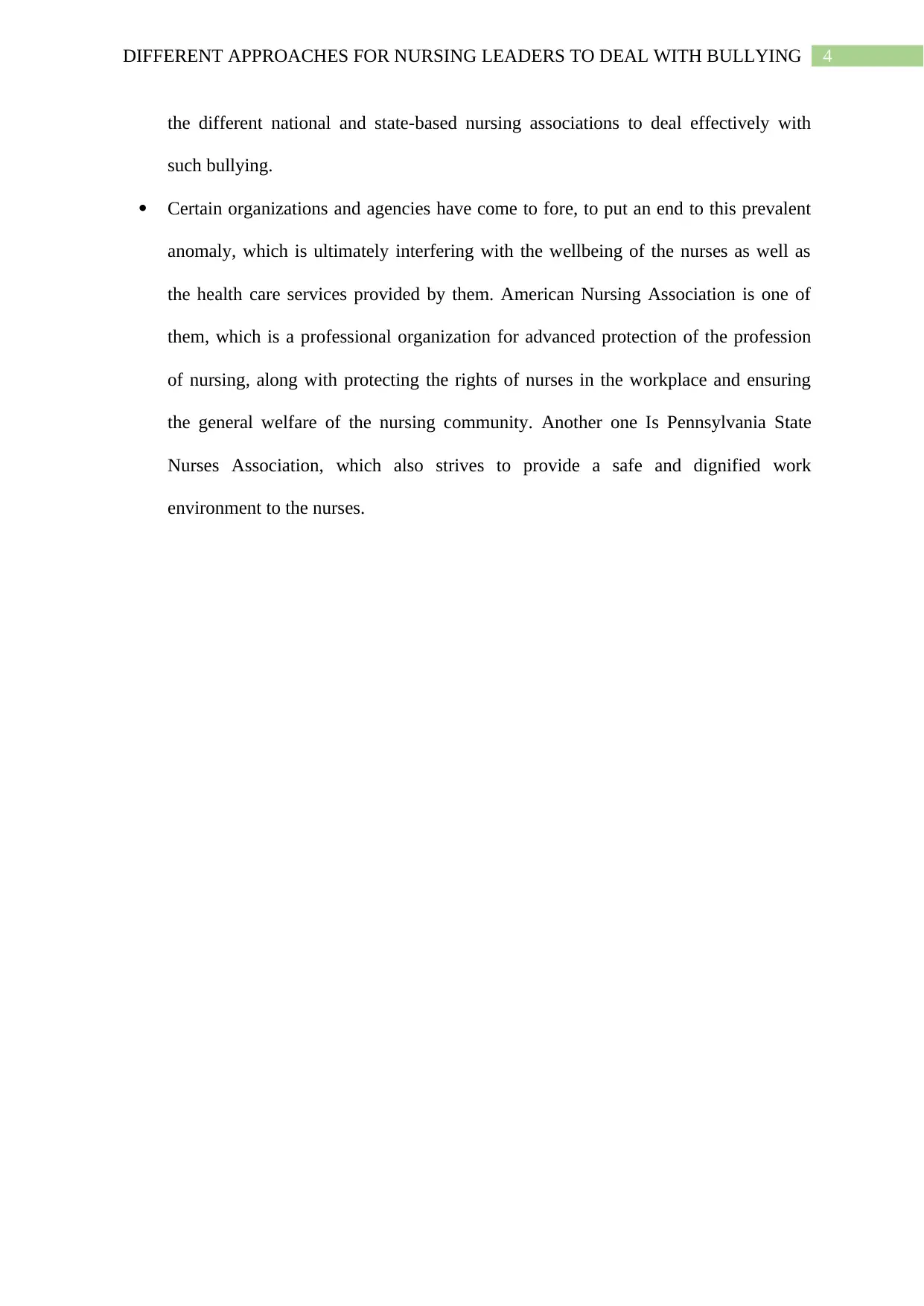
4DIFFERENT APPROACHES FOR NURSING LEADERS TO DEAL WITH BULLYING
the different national and state-based nursing associations to deal effectively with
such bullying.
Certain organizations and agencies have come to fore, to put an end to this prevalent
anomaly, which is ultimately interfering with the wellbeing of the nurses as well as
the health care services provided by them. American Nursing Association is one of
them, which is a professional organization for advanced protection of the profession
of nursing, along with protecting the rights of nurses in the workplace and ensuring
the general welfare of the nursing community. Another one Is Pennsylvania State
Nurses Association, which also strives to provide a safe and dignified work
environment to the nurses.
the different national and state-based nursing associations to deal effectively with
such bullying.
Certain organizations and agencies have come to fore, to put an end to this prevalent
anomaly, which is ultimately interfering with the wellbeing of the nurses as well as
the health care services provided by them. American Nursing Association is one of
them, which is a professional organization for advanced protection of the profession
of nursing, along with protecting the rights of nurses in the workplace and ensuring
the general welfare of the nursing community. Another one Is Pennsylvania State
Nurses Association, which also strives to provide a safe and dignified work
environment to the nurses.
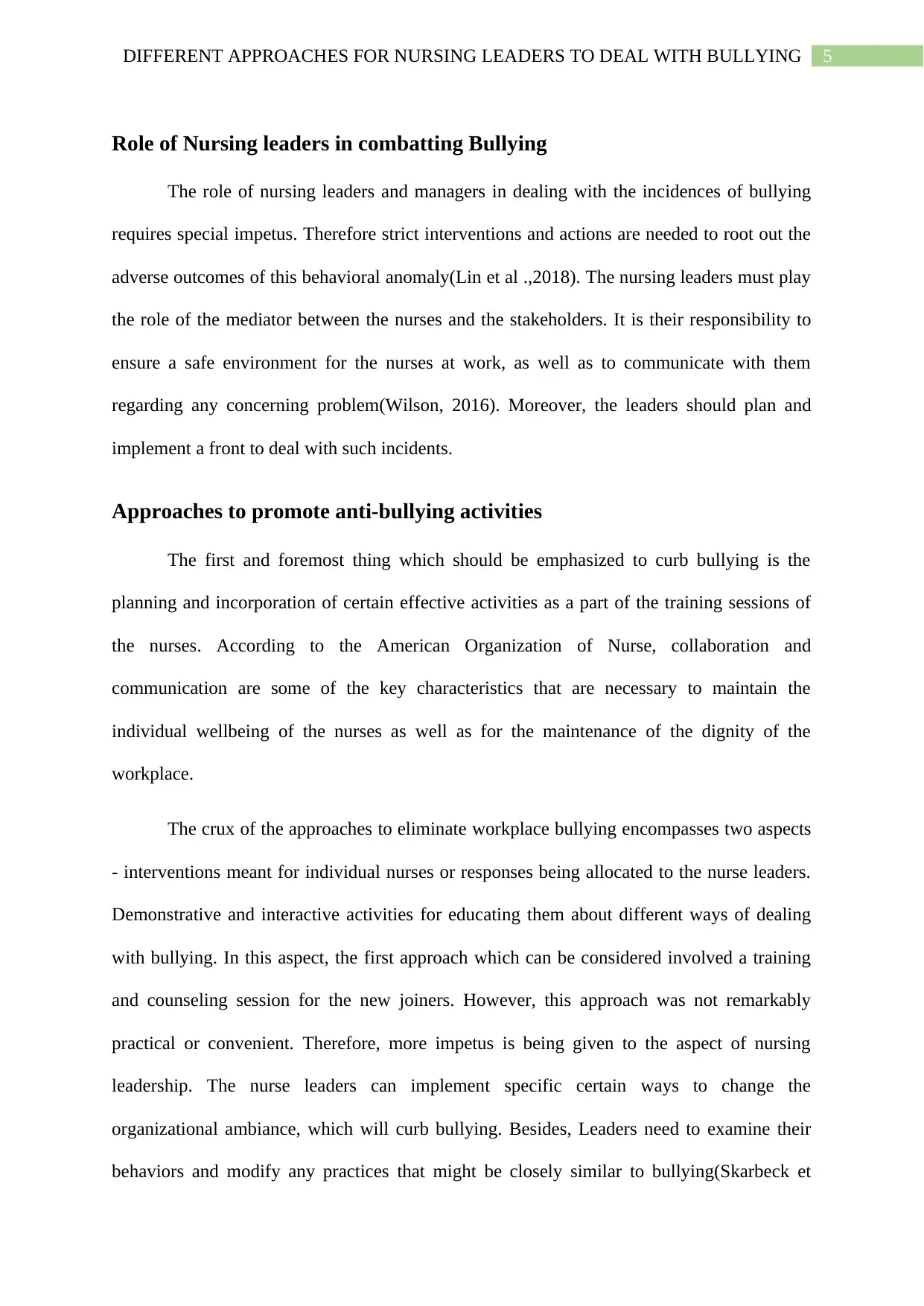
5DIFFERENT APPROACHES FOR NURSING LEADERS TO DEAL WITH BULLYING
Role of Nursing leaders in combatting Bullying
The role of nursing leaders and managers in dealing with the incidences of bullying
requires special impetus. Therefore strict interventions and actions are needed to root out the
adverse outcomes of this behavioral anomaly(Lin et al .,2018). The nursing leaders must play
the role of the mediator between the nurses and the stakeholders. It is their responsibility to
ensure a safe environment for the nurses at work, as well as to communicate with them
regarding any concerning problem(Wilson, 2016). Moreover, the leaders should plan and
implement a front to deal with such incidents.
Approaches to promote anti-bullying activities
The first and foremost thing which should be emphasized to curb bullying is the
planning and incorporation of certain effective activities as a part of the training sessions of
the nurses. According to the American Organization of Nurse, collaboration and
communication are some of the key characteristics that are necessary to maintain the
individual wellbeing of the nurses as well as for the maintenance of the dignity of the
workplace.
The crux of the approaches to eliminate workplace bullying encompasses two aspects
- interventions meant for individual nurses or responses being allocated to the nurse leaders.
Demonstrative and interactive activities for educating them about different ways of dealing
with bullying. In this aspect, the first approach which can be considered involved a training
and counseling session for the new joiners. However, this approach was not remarkably
practical or convenient. Therefore, more impetus is being given to the aspect of nursing
leadership. The nurse leaders can implement specific certain ways to change the
organizational ambiance, which will curb bullying. Besides, Leaders need to examine their
behaviors and modify any practices that might be closely similar to bullying(Skarbeck et
Role of Nursing leaders in combatting Bullying
The role of nursing leaders and managers in dealing with the incidences of bullying
requires special impetus. Therefore strict interventions and actions are needed to root out the
adverse outcomes of this behavioral anomaly(Lin et al .,2018). The nursing leaders must play
the role of the mediator between the nurses and the stakeholders. It is their responsibility to
ensure a safe environment for the nurses at work, as well as to communicate with them
regarding any concerning problem(Wilson, 2016). Moreover, the leaders should plan and
implement a front to deal with such incidents.
Approaches to promote anti-bullying activities
The first and foremost thing which should be emphasized to curb bullying is the
planning and incorporation of certain effective activities as a part of the training sessions of
the nurses. According to the American Organization of Nurse, collaboration and
communication are some of the key characteristics that are necessary to maintain the
individual wellbeing of the nurses as well as for the maintenance of the dignity of the
workplace.
The crux of the approaches to eliminate workplace bullying encompasses two aspects
- interventions meant for individual nurses or responses being allocated to the nurse leaders.
Demonstrative and interactive activities for educating them about different ways of dealing
with bullying. In this aspect, the first approach which can be considered involved a training
and counseling session for the new joiners. However, this approach was not remarkably
practical or convenient. Therefore, more impetus is being given to the aspect of nursing
leadership. The nurse leaders can implement specific certain ways to change the
organizational ambiance, which will curb bullying. Besides, Leaders need to examine their
behaviors and modify any practices that might be closely similar to bullying(Skarbeck et
⊘ This is a preview!⊘
Do you want full access?
Subscribe today to unlock all pages.

Trusted by 1+ million students worldwide
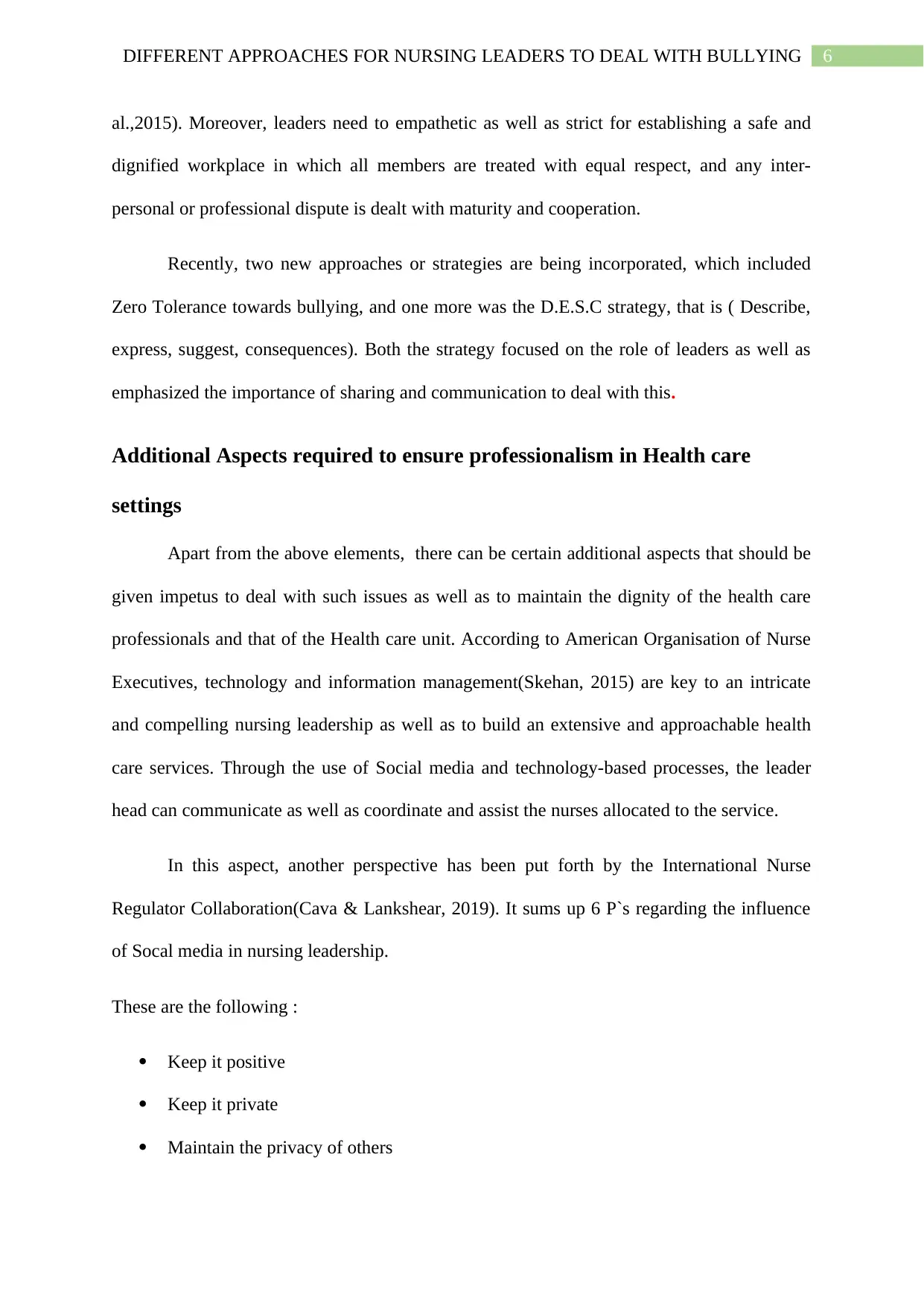
6DIFFERENT APPROACHES FOR NURSING LEADERS TO DEAL WITH BULLYING
al.,2015). Moreover, leaders need to empathetic as well as strict for establishing a safe and
dignified workplace in which all members are treated with equal respect, and any inter-
personal or professional dispute is dealt with maturity and cooperation.
Recently, two new approaches or strategies are being incorporated, which included
Zero Tolerance towards bullying, and one more was the D.E.S.C strategy, that is ( Describe,
express, suggest, consequences). Both the strategy focused on the role of leaders as well as
emphasized the importance of sharing and communication to deal with this.
Additional Aspects required to ensure professionalism in Health care
settings
Apart from the above elements, there can be certain additional aspects that should be
given impetus to deal with such issues as well as to maintain the dignity of the health care
professionals and that of the Health care unit. According to American Organisation of Nurse
Executives, technology and information management(Skehan, 2015) are key to an intricate
and compelling nursing leadership as well as to build an extensive and approachable health
care services. Through the use of Social media and technology-based processes, the leader
head can communicate as well as coordinate and assist the nurses allocated to the service.
In this aspect, another perspective has been put forth by the International Nurse
Regulator Collaboration(Cava & Lankshear, 2019). It sums up 6 P`s regarding the influence
of Socal media in nursing leadership.
These are the following :
Keep it positive
Keep it private
Maintain the privacy of others
al.,2015). Moreover, leaders need to empathetic as well as strict for establishing a safe and
dignified workplace in which all members are treated with equal respect, and any inter-
personal or professional dispute is dealt with maturity and cooperation.
Recently, two new approaches or strategies are being incorporated, which included
Zero Tolerance towards bullying, and one more was the D.E.S.C strategy, that is ( Describe,
express, suggest, consequences). Both the strategy focused on the role of leaders as well as
emphasized the importance of sharing and communication to deal with this.
Additional Aspects required to ensure professionalism in Health care
settings
Apart from the above elements, there can be certain additional aspects that should be
given impetus to deal with such issues as well as to maintain the dignity of the health care
professionals and that of the Health care unit. According to American Organisation of Nurse
Executives, technology and information management(Skehan, 2015) are key to an intricate
and compelling nursing leadership as well as to build an extensive and approachable health
care services. Through the use of Social media and technology-based processes, the leader
head can communicate as well as coordinate and assist the nurses allocated to the service.
In this aspect, another perspective has been put forth by the International Nurse
Regulator Collaboration(Cava & Lankshear, 2019). It sums up 6 P`s regarding the influence
of Socal media in nursing leadership.
These are the following :
Keep it positive
Keep it private
Maintain the privacy of others
Paraphrase This Document
Need a fresh take? Get an instant paraphrase of this document with our AI Paraphraser
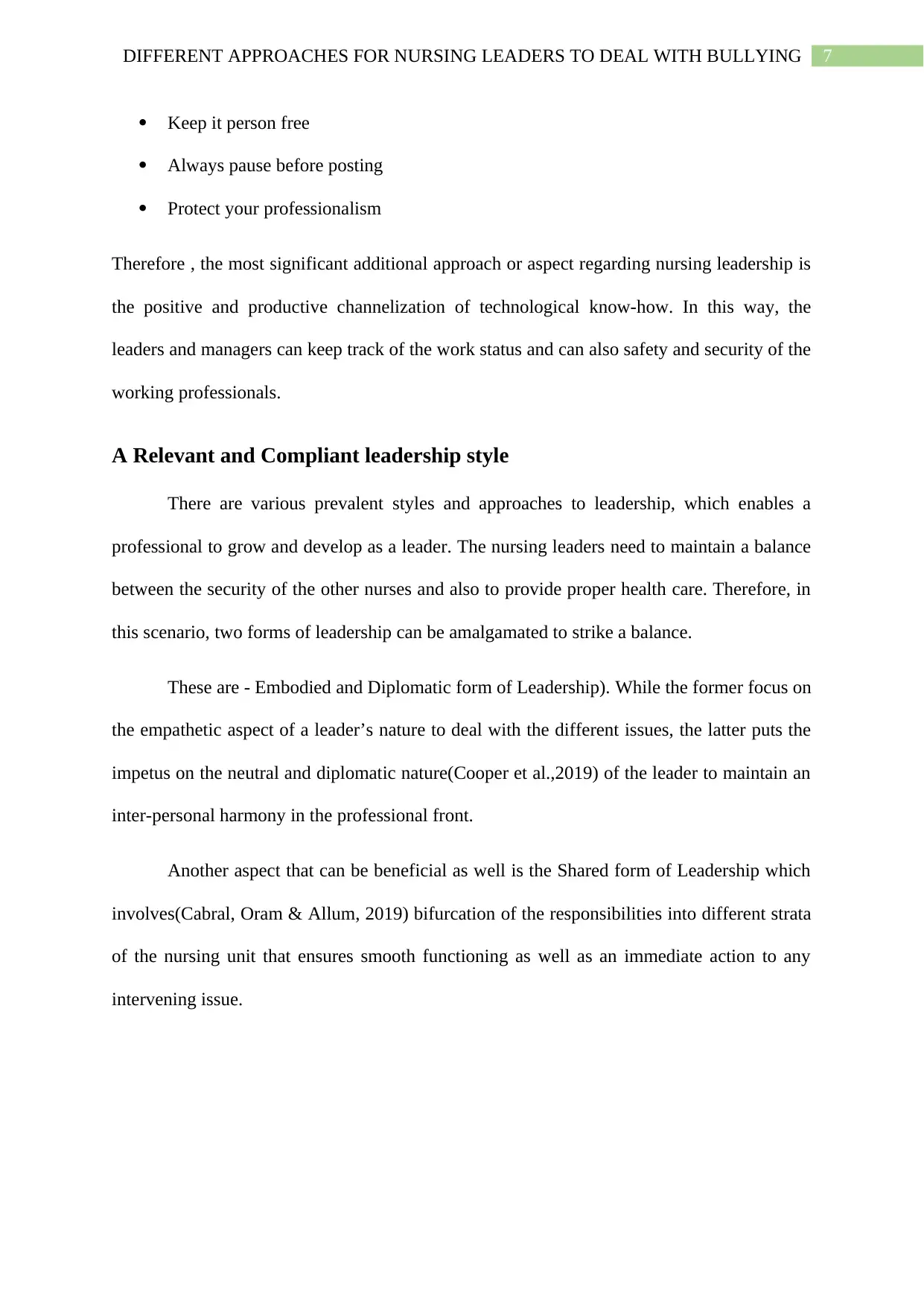
7DIFFERENT APPROACHES FOR NURSING LEADERS TO DEAL WITH BULLYING
Keep it person free
Always pause before posting
Protect your professionalism
Therefore , the most significant additional approach or aspect regarding nursing leadership is
the positive and productive channelization of technological know-how. In this way, the
leaders and managers can keep track of the work status and can also safety and security of the
working professionals.
A Relevant and Compliant leadership style
There are various prevalent styles and approaches to leadership, which enables a
professional to grow and develop as a leader. The nursing leaders need to maintain a balance
between the security of the other nurses and also to provide proper health care. Therefore, in
this scenario, two forms of leadership can be amalgamated to strike a balance.
These are - Embodied and Diplomatic form of Leadership). While the former focus on
the empathetic aspect of a leader’s nature to deal with the different issues, the latter puts the
impetus on the neutral and diplomatic nature(Cooper et al.,2019) of the leader to maintain an
inter-personal harmony in the professional front.
Another aspect that can be beneficial as well is the Shared form of Leadership which
involves(Cabral, Oram & Allum, 2019) bifurcation of the responsibilities into different strata
of the nursing unit that ensures smooth functioning as well as an immediate action to any
intervening issue.
Keep it person free
Always pause before posting
Protect your professionalism
Therefore , the most significant additional approach or aspect regarding nursing leadership is
the positive and productive channelization of technological know-how. In this way, the
leaders and managers can keep track of the work status and can also safety and security of the
working professionals.
A Relevant and Compliant leadership style
There are various prevalent styles and approaches to leadership, which enables a
professional to grow and develop as a leader. The nursing leaders need to maintain a balance
between the security of the other nurses and also to provide proper health care. Therefore, in
this scenario, two forms of leadership can be amalgamated to strike a balance.
These are - Embodied and Diplomatic form of Leadership). While the former focus on
the empathetic aspect of a leader’s nature to deal with the different issues, the latter puts the
impetus on the neutral and diplomatic nature(Cooper et al.,2019) of the leader to maintain an
inter-personal harmony in the professional front.
Another aspect that can be beneficial as well is the Shared form of Leadership which
involves(Cabral, Oram & Allum, 2019) bifurcation of the responsibilities into different strata
of the nursing unit that ensures smooth functioning as well as an immediate action to any
intervening issue.
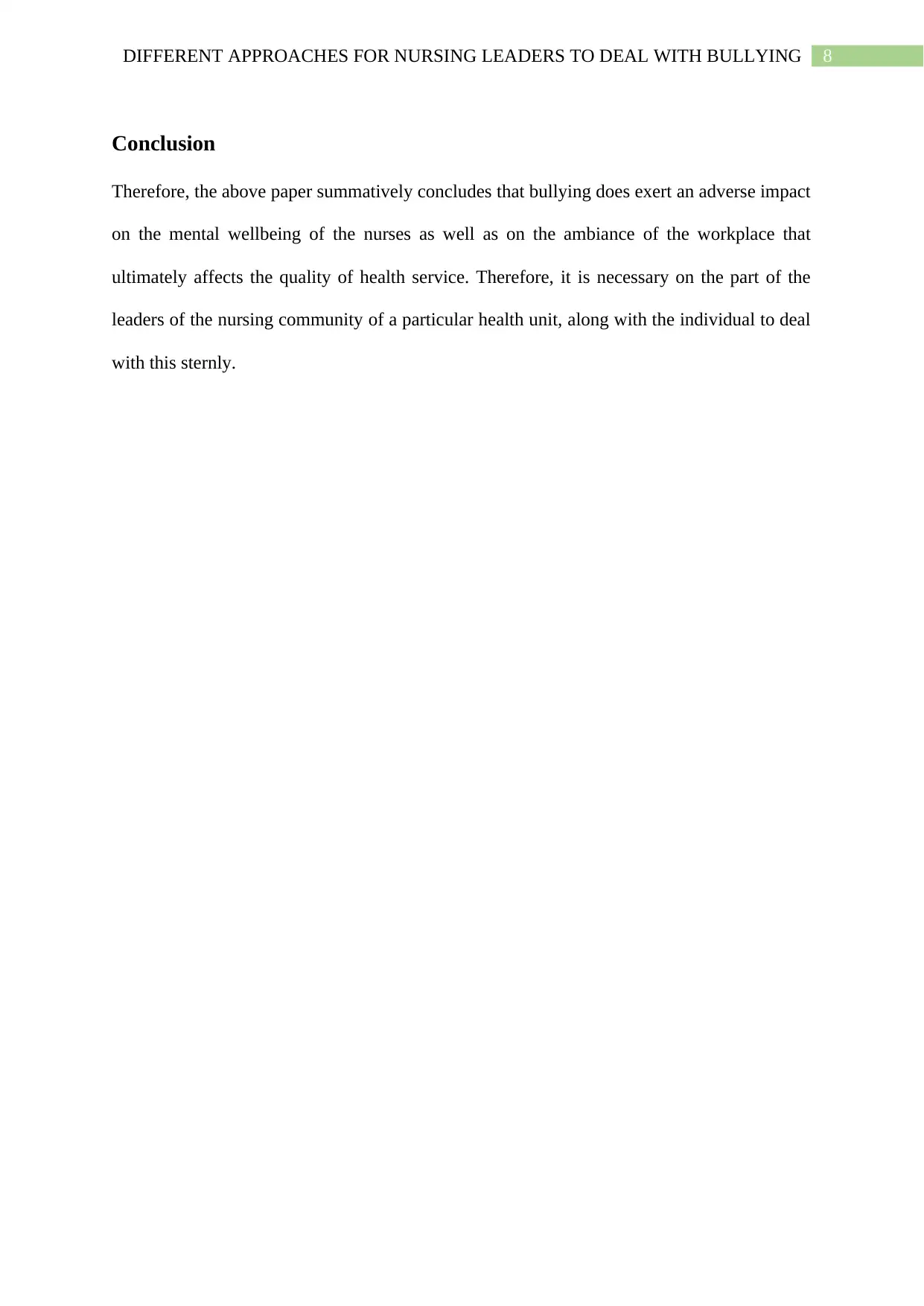
8DIFFERENT APPROACHES FOR NURSING LEADERS TO DEAL WITH BULLYING
Conclusion
Therefore, the above paper summatively concludes that bullying does exert an adverse impact
on the mental wellbeing of the nurses as well as on the ambiance of the workplace that
ultimately affects the quality of health service. Therefore, it is necessary on the part of the
leaders of the nursing community of a particular health unit, along with the individual to deal
with this sternly.
Conclusion
Therefore, the above paper summatively concludes that bullying does exert an adverse impact
on the mental wellbeing of the nurses as well as on the ambiance of the workplace that
ultimately affects the quality of health service. Therefore, it is necessary on the part of the
leaders of the nursing community of a particular health unit, along with the individual to deal
with this sternly.
⊘ This is a preview!⊘
Do you want full access?
Subscribe today to unlock all pages.

Trusted by 1+ million students worldwide
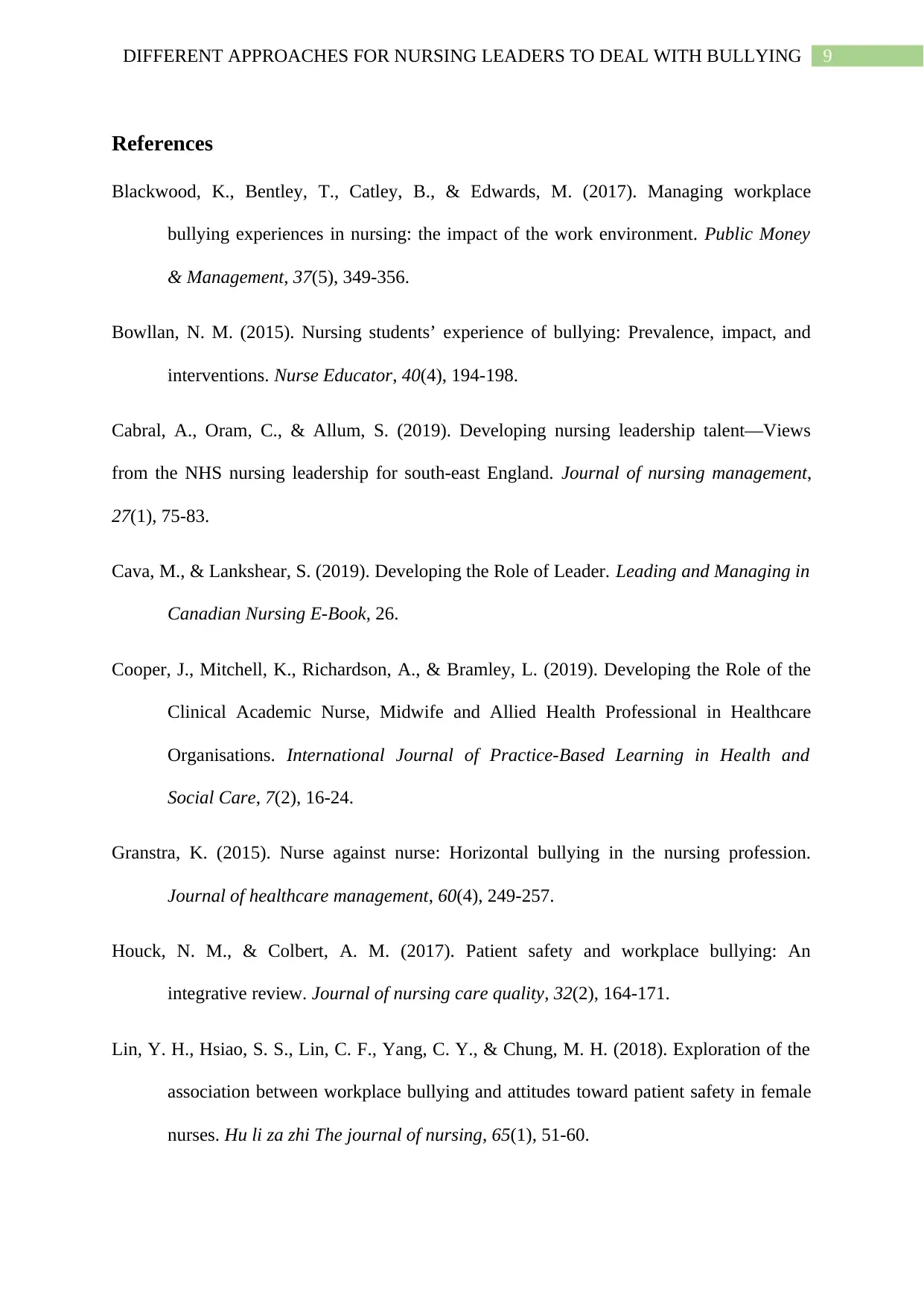
9DIFFERENT APPROACHES FOR NURSING LEADERS TO DEAL WITH BULLYING
References
Blackwood, K., Bentley, T., Catley, B., & Edwards, M. (2017). Managing workplace
bullying experiences in nursing: the impact of the work environment. Public Money
& Management, 37(5), 349-356.
Bowllan, N. M. (2015). Nursing students’ experience of bullying: Prevalence, impact, and
interventions. Nurse Educator, 40(4), 194-198.
Cabral, A., Oram, C., & Allum, S. (2019). Developing nursing leadership talent—Views
from the NHS nursing leadership for south‐east England. Journal of nursing management,
27(1), 75-83.
Cava, M., & Lankshear, S. (2019). Developing the Role of Leader. Leading and Managing in
Canadian Nursing E-Book, 26.
Cooper, J., Mitchell, K., Richardson, A., & Bramley, L. (2019). Developing the Role of the
Clinical Academic Nurse, Midwife and Allied Health Professional in Healthcare
Organisations. International Journal of Practice-Based Learning in Health and
Social Care, 7(2), 16-24.
Granstra, K. (2015). Nurse against nurse: Horizontal bullying in the nursing profession.
Journal of healthcare management, 60(4), 249-257.
Houck, N. M., & Colbert, A. M. (2017). Patient safety and workplace bullying: An
integrative review. Journal of nursing care quality, 32(2), 164-171.
Lin, Y. H., Hsiao, S. S., Lin, C. F., Yang, C. Y., & Chung, M. H. (2018). Exploration of the
association between workplace bullying and attitudes toward patient safety in female
nurses. Hu li za zhi The journal of nursing, 65(1), 51-60.
References
Blackwood, K., Bentley, T., Catley, B., & Edwards, M. (2017). Managing workplace
bullying experiences in nursing: the impact of the work environment. Public Money
& Management, 37(5), 349-356.
Bowllan, N. M. (2015). Nursing students’ experience of bullying: Prevalence, impact, and
interventions. Nurse Educator, 40(4), 194-198.
Cabral, A., Oram, C., & Allum, S. (2019). Developing nursing leadership talent—Views
from the NHS nursing leadership for south‐east England. Journal of nursing management,
27(1), 75-83.
Cava, M., & Lankshear, S. (2019). Developing the Role of Leader. Leading and Managing in
Canadian Nursing E-Book, 26.
Cooper, J., Mitchell, K., Richardson, A., & Bramley, L. (2019). Developing the Role of the
Clinical Academic Nurse, Midwife and Allied Health Professional in Healthcare
Organisations. International Journal of Practice-Based Learning in Health and
Social Care, 7(2), 16-24.
Granstra, K. (2015). Nurse against nurse: Horizontal bullying in the nursing profession.
Journal of healthcare management, 60(4), 249-257.
Houck, N. M., & Colbert, A. M. (2017). Patient safety and workplace bullying: An
integrative review. Journal of nursing care quality, 32(2), 164-171.
Lin, Y. H., Hsiao, S. S., Lin, C. F., Yang, C. Y., & Chung, M. H. (2018). Exploration of the
association between workplace bullying and attitudes toward patient safety in female
nurses. Hu li za zhi The journal of nursing, 65(1), 51-60.
Paraphrase This Document
Need a fresh take? Get an instant paraphrase of this document with our AI Paraphraser
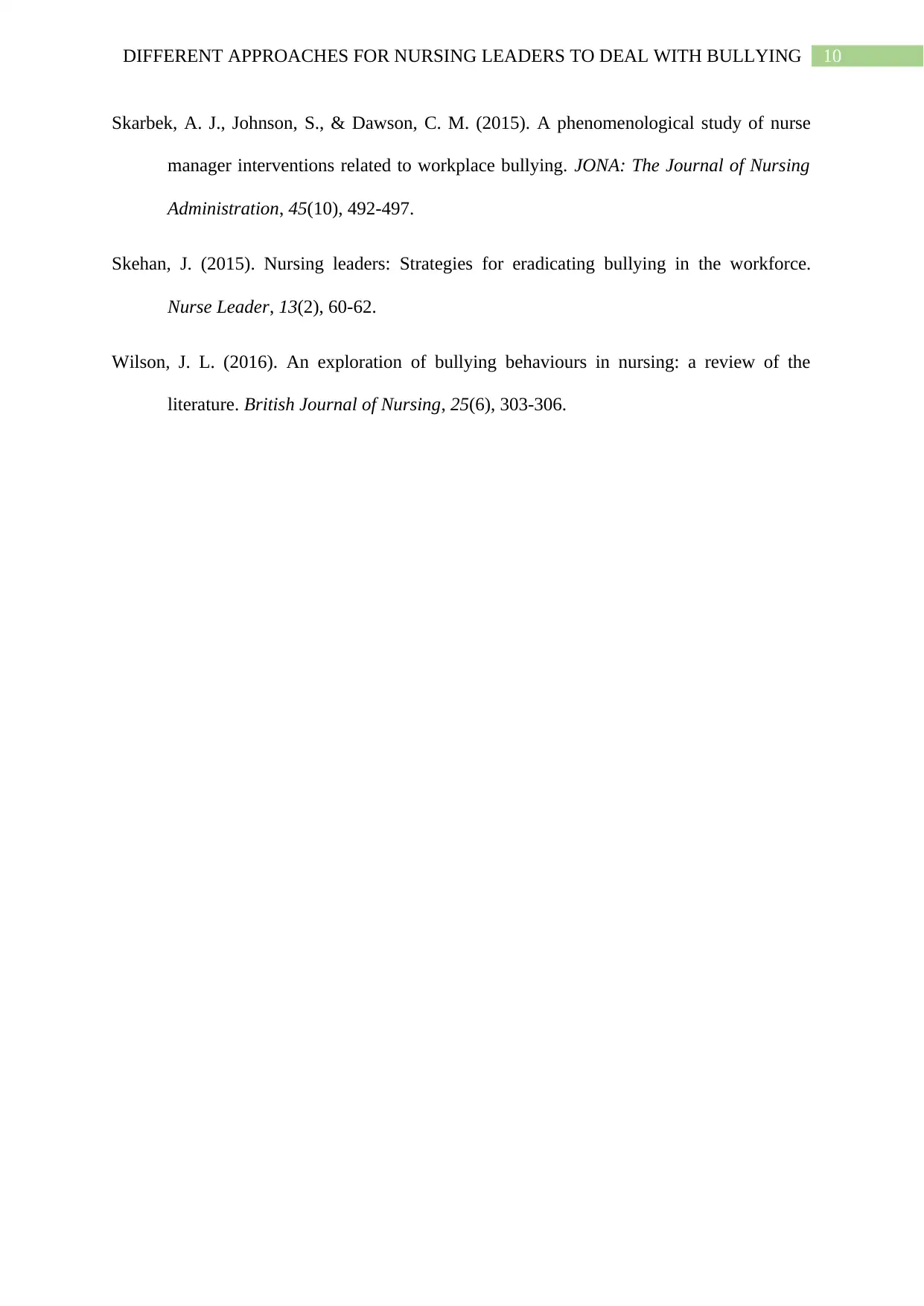
10DIFFERENT APPROACHES FOR NURSING LEADERS TO DEAL WITH BULLYING
Skarbek, A. J., Johnson, S., & Dawson, C. M. (2015). A phenomenological study of nurse
manager interventions related to workplace bullying. JONA: The Journal of Nursing
Administration, 45(10), 492-497.
Skehan, J. (2015). Nursing leaders: Strategies for eradicating bullying in the workforce.
Nurse Leader, 13(2), 60-62.
Wilson, J. L. (2016). An exploration of bullying behaviours in nursing: a review of the
literature. British Journal of Nursing, 25(6), 303-306.
Skarbek, A. J., Johnson, S., & Dawson, C. M. (2015). A phenomenological study of nurse
manager interventions related to workplace bullying. JONA: The Journal of Nursing
Administration, 45(10), 492-497.
Skehan, J. (2015). Nursing leaders: Strategies for eradicating bullying in the workforce.
Nurse Leader, 13(2), 60-62.
Wilson, J. L. (2016). An exploration of bullying behaviours in nursing: a review of the
literature. British Journal of Nursing, 25(6), 303-306.
1 out of 11
Related Documents
Your All-in-One AI-Powered Toolkit for Academic Success.
+13062052269
info@desklib.com
Available 24*7 on WhatsApp / Email
![[object Object]](/_next/static/media/star-bottom.7253800d.svg)
Unlock your academic potential
Copyright © 2020–2025 A2Z Services. All Rights Reserved. Developed and managed by ZUCOL.





